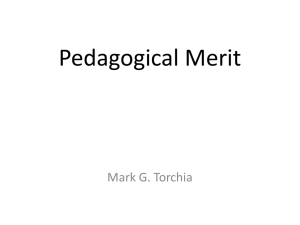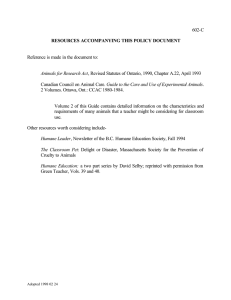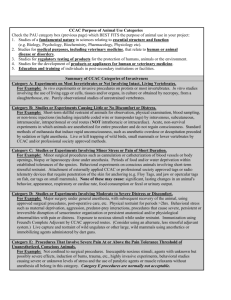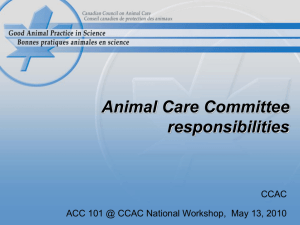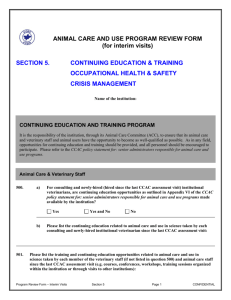Document 10802728
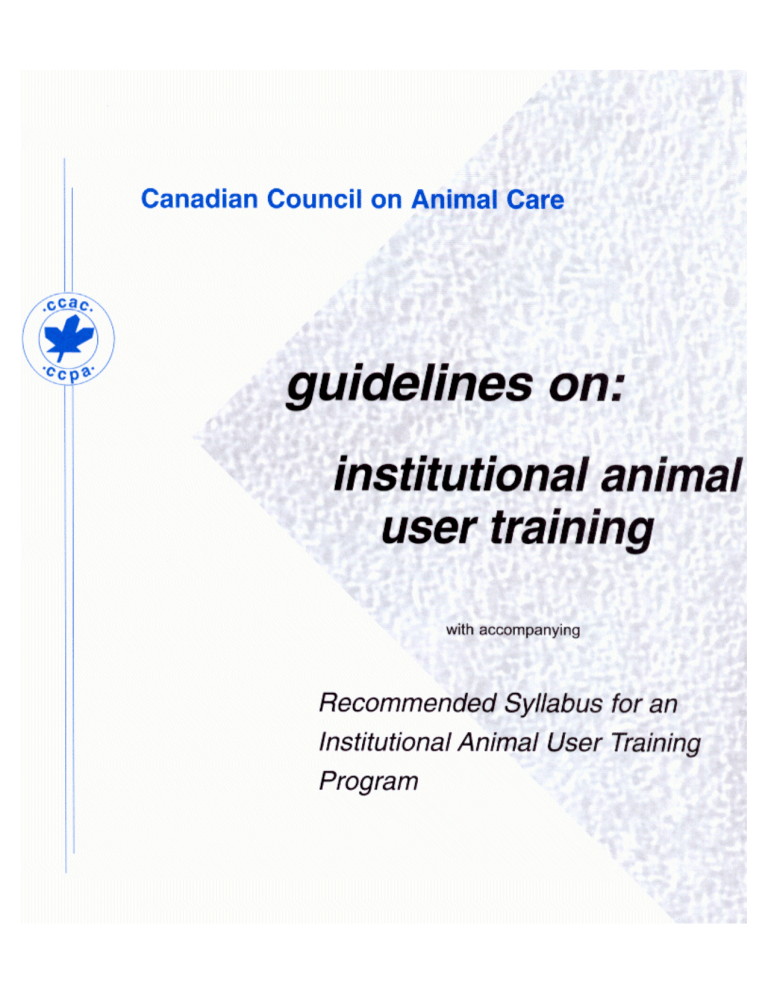
The CCAC guidelines on: institutional animal user training and CCAC Recommended
Syllabus for an Institutional Animal User Training Program were developed by the
CCAC Education and Training Committee:
Dr Karen Gibson (Chair), University of Prince Edward Island (CCFAVM)
Dr Craig Bihun, Institute for Biological Sciences, National Research Council (ad hoc)
Ms Rosemary Cavan, Association of Universities and Colleges of Canada (ad hoc)
Dr Howard Dickson, Dalhousie University (MRC)
Mr Robert Madziak, The University of Manitoba (CALAS)
Dr Lawrence Schofield, Defence Research Establishment Suffield (National Defence)
The CCAC is also grateful to the many individuals, organizations and associations, that provided comments on earlier drafts of these guidelines and syllabus.
1999
TABLE OF CONTENTS
GUIDELINES
PHILOSOPHY OF AN ANIMAL USER TRAINING PROGRAM
ACCESS TO THE TRAINING PROGRAM
RECOMMENDED SYLLABUS
CORE TOPICS/ALL ANIMAL USERS PARTICIPATE a.
Regulations and animal welfare b.
Moral, legal, and ethical issues c.
Basic animal care/animal biology/techniques c.
Occupational health and safety
Facility specific operational items
TOPICS TO BE COVERED IN MODULES/NOT PART OF CORE COURSE,
BUT AVAILABLE ON REGULAR BASIS WHEN APPLICABLE a.
Topics to be developed for appropriate species, as required
Conducting research, teaching, or testing using fish
CCAC guidelines on: institutional animal user training (1999)
The Canadian Council on Animal Care (CCAC) is responsible for overseeing the care and use of animals for research, teaching and testing. In addition to the CCAC Guide
to the Care and Use of Experimental Animals, Vol. 1, 2nd Edn., 1993 and Vol. 2,
1984 which delineates general principles for the care and use of experimental animals, the CCAC also publishes guidelines on issues of current and emerging concerns . The CCAC guidelines on: institutional animal user training is the fourth of this series and has been produced by the Education and Training Committee of the
CCAC.
These guidelines implement the CCAC National Institutional Animal User Training
(NIAUT) Program, which consists of the guidelines themselves, the accompanying
Recommended Syllabus for an Institutional Animal User Training Program , and resource material to support the development and implementation of an institutional training program based on the Recommended Syllabus. The guidelines present training requirements for institutional animal users (including investigators, postdoctoral fellows, research staff and graduate students) which will become mandatory for participants in the CCAC Assessment Program , by January 2003. The guidelines have been developed to assist institutions in ensuring that their training programs are adequate and to help establish a national standard for such programs.
The CCAC recognizes that many institutions have excellent training programs in place. The guidelines should in no way detract from these programs and, in fact, borrow much from both the training programs and the experiences of these institutions. The CCAC NIAUT Program implemented through these guidelines, consists of a flexible modular program including a Recommended Syllabus for an
Institutional Animal User Training Program which indicates the topics to be covered.
The flexibility of the program will permit institutions to design training programs tailored to the needs of individuals using animals within their facilities. The intent of the accompanying Recommended Syllabus is to assist institutions in ensuring that all core material required by the CCAC is included.
The CCAC guidelines on: institutional animal user training will also provide institutions with the scope of the program required to ensure adequate training. The
CCAC recognizes that significant resources are required to build a comprehensive training program, and institutions must recognize these responsibilities in this regard if sound humane animal research is to be carried out within their facilities. The CCAC is committed to assisting institutions by providing the accompanying Recommended
Syllabus , as well as resource materials that will be updated on a regular basis in support of the Syllabus.
General Guideline: All personnel involved with the use of animals in research, teaching and testing must be adequately trained in the principles
of laboratory animal science and the ethical issues involved in animal use.
Adequate training for all personnel is an essential component of any animal care and use program to ensure that animals are used in the most humane and ethical manner.
Reference to training is made in several places in the CCAC Guide to the Care and
Use of Experimental Animals, Vol. 1, 2nd Edn., 1993 and in other CCAC guidelines and policies . For example, animal care committees are given the responsibility to
"Establish and implement policies, which will provide for a system of animal care that will meet the needs of the institution and include: ....the training and qualification of animal users and animal care personnel." (CCAC Terms of Reference for Animal Care
Committees .)
The CCAC Syllabus of the Basic Principles of Laboratory Animal Science, 1983 assisted many institutions in establishing training programs; however, it has become apparent that not all personnel in all institutions assessed by the CCAC are receiving adequate levels of training. Therefore, the CCAC guidelines on: institutional animal
user training, the accompanying Recommended Syllabus for an Institutional Animal
User Training Program and resource material will supersede the 1983 syllabus.
1.
Philosophy of an Animal User Training Program
Guideline: Institutions must strive through their training programs to
sustain an institutional culture of respect for animal life.
The purpose of any animal user training program is to foster a philosophy of compassion and respect for the animals used in research, teaching and testing. Secondly, the training program should provide participants with the necessary knowledge base and technical skills to carry out required procedures, and to promote quality science based on appropriate use of animals by skilled individuals.
All personnel using animals need to be aware of the ethical dilemmas and spectra of views related to institutional animal use in Canada, and that the majority of Canadians are concerned about the humane care and treatment of experimental animals. All aspects of the training program should, therefore, incorporate this philosophy of compassion, so that participants not only gain the technical skills necessary to perform animal-based science, but in addition, enhance their respect for animal life.
2.
Course Design
Guideline: The training program to be implemented by an institution must include all core areas to be delivered to all participants. In addition, modules should be designed which are species specific and procedure specific, targeted to the needs of the individual animal
users within the institution.
All personnel involved in the care and use of animals for research, teaching and testing must possess: o adequate knowledge of the principles of experimental animal science relevant to their area of work (laboratory, field, or agriculture); o the technical skills required for any procedure they must carry out; and o an appreciation of the ethical issues of using animals for scientific purposes in Canada.
The CCAC Recommended Syllabus indicates core areas in which all personnel must participate, and recommends additional modules to be developed, depending on the needs of the animal users within an institution. Personnel
(for example, project supervisors), who do not participate in the hands on experimental procedures, may not be required to participate in the practical sections of the Recommended Syllabus , but will need to participate in core modules on ethics, regulations and principles of experimental animal science
(for laboratory, field or agriculture).
For the purpose of these guidelines, the breakdown of core and non-core items has been developed to enhance flexibility and to suit the needs of all animal users (e.g., investigators, post-doctoral fellows, research staff and graduate students). However, sections of an institutional training program may also be suitable for the education of animal care technicians as well as members of animal care committees.
3.
Resource Material
Guideline: Institutions are responsible for assembling appropriate resource material to support the delivery of a comprehensive, current
training program.
There is a wealth of information available to support both the core and noncore modules described in the CCAC Recommended Syllabus . The CCAC will review and maintain a recommended list of resource materials to be used in conjunction with the CCAC Recommended Syllabus. The material presented in the training programs of several Canadian institutions constitutes an important part of the available resources.
There are electronic media and various models available to assist in teaching techniques; however, effective technique training requires hands on demonstration and practice. Institutions must be aware of the considerable resources required to deliver an effective and timely training program, in particular to teach practical skills.
4.
Access to the Training Program
Guideline: The training program must be offered on a regular basis to ensure that all animal users receive adequate training prior to
commencement of any animal-based work.
There is the potential for animals to experience unnecessary and avoidable pain and/or distress when subjected to experimental procedures by inexperienced individuals who have not received the appropriate training.
Therefore, the institution must ensure that all personnel using animals participate in the appropriate core and non-core training modules and have adequate supervision during initial animal use.
Each institution will have to assess the demand for training, in order to determine how frequently training courses need to be provided so that animal-based projects are not delayed unduly. Following initial participation in an institutional training program, it is recommended that all personnel attend a refresher course after five years, and that additional modules be attended by individuals as their activities or responsibilities change.
Institutions may elect to adopt a training program offered by another institution willing to share their training resources. Alternatively institutions may send their animal users to another institution for training.
It is recognized that institutions frequently have people arriving and departing throughout the year, including visitors and students involved in short-term projects. It may prove to be too resource intensive to fully train such individuals, but limited training must be offset by more intensive supervision of these individuals.
5.
Performance Evaluation
Guideline: Institutions are responsible for providing evidence that all
personnel have been adequately trained in the required areas.
The real test of an institution's effective use of the guidelines will be through internal performance review. Animal facility directors and managers, as well as animal care committees will be responsible for ensuring that all personnel have been adequately trained. In particular, animal care committees should ensure that all personnel listed on an animal use protocol have received the appropriate training before the protocol is undertaken. Institutions will need to maintain records to document training.
Recommended Syllabus for an Institutional
Animal User Training Program (1999)
A.
Core Topics/All Animal Users Participate: a.
Regulations and animal welfare o overview of Canadian Council on Animal Care: guidelines and policies/educational tools/Assessment Program/peer review system o role of the local animal care committee in overseeing animal use and maintaining standards o applicable regulations and legislation o animal user accountability to ensure ethical animal use b.
Moral, legal, and ethical issues o animal welfare movement
concerns of the public regarding humane treatment of animals o foundations for ethical considerations concerning animal use o contentious issues; recognition of various aspects and views
examples of evaluation of competing ethical demands (case studies of ethical dilemmas); ethical problems of allocation of resources (e.g., provision of enrichment in housing); level of invasiveness versus potential benefit (examples) o scientific integrity and scholarly activity - responsible use of animals c.
The concept of the Three Rs i.
Reduction o appropriate animal numbers - statistical requirements (power analysis)
controlling variability
literature searches ii.
Refinement o onus to achieve expertise/limit pain/prevent wasting of animals o expertise can reduce variability thus reducing numbers required iii.
Replacement o alternatives
the need to consider
resources/databases
1.
Lab Animal/Teaching Stream
For animal users involved in research, teaching and testing using laboratory animal, companion animal and farm animal species: a.
Research issues o influence of environment/husbandry on research o influence of disease on research o effects of stress on animals - causes of stress o responsibility of the investigator o anesthesia/analgesia overview
o euthanasia
definition
appropriate methods
effects on research
effects on personnel o animal models/appropriate selection/resources o
CCAC categories of invasiveness b.
Basic animal care/animal biology/techniques o animal facilities and husbandry o basic knowledge of facility operation to consider effects on research/stress producing situations o environmental enrichment/reduction of stress o roles of the animal care veterinarian/animal care technicians and how their activities can impact research o role of the animal care technician as an observer, source of information/data collection/part of the research team o awareness of technical services/source of expertise/variability reduction through consistent/competent manipulations o animal identification/importance in terms of lost/confounded data o animal health monitoring o disinfectants and sterilization o use of facility Standard Operating Procedures (SOPs) o animal procurement - general considerations o recognition of pain and/or distress - endpoints c.
Occupational health and safety
Review of hazards involved in working with animals: o physical hazards
noise, electrical, radiation o chemical hazards
hazard awareness and right to know legislation; flammable, corrosive and toxic agents o biological hazards
zoonotics: rabies; cercopithecine; Herpes B; Q-fever
biohazards, review of risk levels 1-4 with examples
bites and scratches
laboratory animal allergy - how allergies develop, preventive measures and intervention strategies o facility specific operational items
legislated training requirement of Provincial Occupational Health and Safety Acts
local occupational health and safety programs and administration of WHMIS
medical surveillance programs
accident procedures and reporting
d.
Facility specific operational items o approval and use of animals at the specific facility - local animal care committee structure o tours of facility o introduction to personnel o security o group discussions of animal use proposals, e.g., of how to complete institutional applications o local animal procurement procedures/disposal o
Standard Operating Procedures (SOPs) and record forms o local occupational health and safety programs and administration o drug acquisition, storage, use and record keeping o principles of containment systems for housing infected animals o principles of exclusion housing; clean air stations and facilities for immune suppressed animals
2.
Wildlife Stream
For animal users involved in research, teaching and testing using wildlife species in the field. Topics to be developed for the appropriate species, as required:
Aquatic species o ethical considerations
effects on animals, ecology (including animals threatened with extinction) and humans
causes and effects of stress on animals
public concerns
role of the institutional animal care committee
justification o controls/regulations
Canadian Council on Animal Care
Canadian Wildlife Service
Fisheries and Oceans Canada
provincial permits
scuba diving training (provincial diving regulations) o potential hazards and precautions
chemicals (immobilizing agents, disinfectants, marking agents, etc.)
potential zoonoses
environmental hazards o common techniques for observation o acceptable capture and immobilization techniques o handling/restraint o marking techniques
o health evaluation o common tissue sampling/blood sampling techniques o short-term and long-term holding/husbandry o release (yes/no?; implications) o anesthesia/analgesia o euthanasia in the field
B.
Topics to be Covered in Modules/not Part of Core Course, but
Available on Regular Basis When Applicable: a.
Topics to be developed for the appropriate species, as required:
Rodents Horses
Rabbits Amphibia
Cats Reptiles
Dogs Birds
Poultry Goats
Sheep Cephalopods i.
General o overview of biology and diseases o handling, restraint and common techniques (Codes of Practice) o necropsy/sampling o recognition of pain and/or distress o anesthesia o analgesia o surgical principles
animal preparation, including health monitoring aspects, site preparation, induction
aseptic technique
instrument sterilization
multiple survival surgeries on a single animal
surgical procedures on a series of animals
post-operative monitoring and pain management
records ii.
Specialized techniques o food deprivation/motivation techniques o diet manipulations o adjuvant use o transgenic animals
b.
Conducting research, teaching, or testing using fish o biology and behavior o capture and transportation o permits and regulations o acclimation o handling and restraint o tagging and marking o holding systems (tanks, water delivery systems, environmental control and monitoring, equipment), water management and quality, flow rates, oxygen, water filtration, other environmental requirements o health and disease o general husbandry and aquaculture strategies o nutrition and feeding o common problems in aquatic facilities (supersaturation, chlorine, pollutants, etc.) o transgenic techniques o anesthesia o surgery o specialized techniques (e.g., cannulation) o euthanasia
